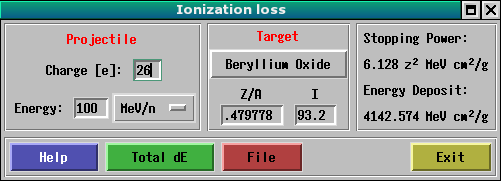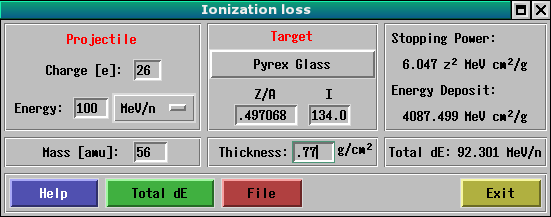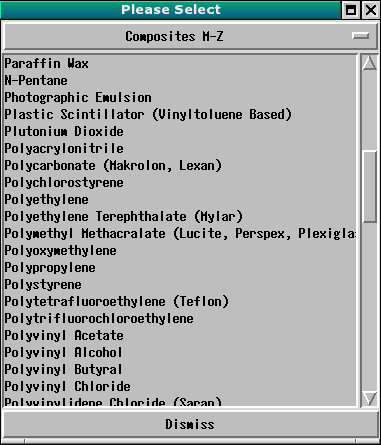
This was originally created in IDL(RSI) back in the early nineties when I learned to program under X. Later I translated it into Tcl/Tk, mostly to get it out of proprietary software out into the open.

When this program starts up, you are given the option to enter the charge and kinetic energy per nucleon of an incident particle and the material properties of a target. The program will then compute the stopping power and specific energy deposit of the projectile in the target. The computation is run-of-the-mill Bethe-Bloch.
If you're looking for more complexity, hit the green "Total dE" button: this will open two more inputs where you can specify the mass of your particle and the actual thickness of the target and the program will compute the actual total energy deposit in the target.

This is done by propagating the particle through thin slices of the target, computing the energy loss in each slice.
Thus it will tend to yield more total energy loss than multiplying stopping power with grammage by a factor that depends on the fractional energy loss and the charge of the projectile (since a low-Z projectile will lose the same amount of energy in more frequent smaller packets than high-Z ones).
The distance travelled in the 'total dE' calculation is the projected distance along the original path, i.e. no scattering corrections are taken into account. At 800keV/n the 'real' path of an alpha projectile in matter will be about 10% or so longer than this projected distance.
In other words: at small energies, you may have to increase the grammage entered in "Thickness" by an appropriate amount since the particle will not traverse the target in a straight line. Above a few MeV/n this should almost never be an issue, but if your target thickness is flirting with stopping grammage, keep in mind that a particle which is computed to "just barely" make it through the target will probably not actually emerge on the other side as its real path is longer than the geometric thickness of the target.
The 'File' button simply writes the current results to a file with the name 'bbt.out'. If the file already exists, the results will be appended.
Clicking on the name of the target material opens the materials selector:

To keep it reasonably uncluttered, it was split into "Elements" and "Composites" - and the latter into "A-L" and "M-Z". These categories can be selected with the drop-down at the top. The data in this collection was cobbled together from a number of sources, but the NIST STaR database shines prominently here and needs to be acknowledged.
Note that a composite could be listed under a common or trade name or under the chemical name. For example, in the above picture you see that Mylar is listed under 'P' for Polyethylene Terephtalate. Thus if you can't find some common product, check whether it is listed under its correct name.
Linux: You can download the TCL/Tk script right here; make it executable and call it by name.
For Windows: You can also download a standalone executable right here; it needs no "installation" or such - you double-click it and it "just runs".
For all OS: This program is written in plain Tcl/Tk - which means the script will run on all computers with a working installation of Tcl/Tk. Most unixoid/linuxoid OS have TCL by default, but it exists for Windows and MacOS as well (and it's free). I have tested it under two linux flavors, Sun/Solaris and WinXP, but as there are no particular tricks in it, I see no real reason why it shouldn't run just fine on other platforms. Try it and let me know.
If you'd really like to have a standalone binary for other OSes, let me know and I can probably generate one.




